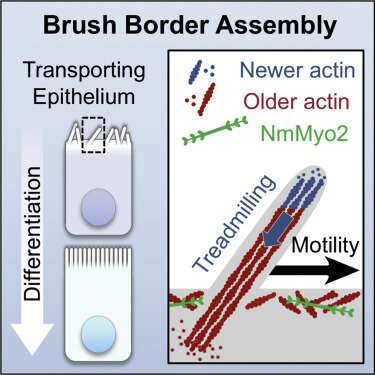Microvilli in motion: Live cell imaging to visualize early steps of brush border formation

Microvilli are protrusions on the surface of epithelial cells that are dedicated to mechanosensation in the inner ear, and chemosensation and solute uptake in the lungs, gut, intestine and urinary tract. Epithelial cells assemble dense arrays of microvilli called "brush borders" that protect against infections and injury.
Leslie Meenderink, MD, Ph.D., Matthew Tyska, Ph.D., and colleagues used live cell imaging to visualize early steps of brush border formation.
They found that individual microvilli exhibit persistent active motility. Driven by actin assembly at the barbed ends of core bundles, microvilli motility allows the protrusions to collide and cluster into highly organized arrays.
The research, featured on the cover of the Sept. 9 issue of Developmental Cell, points to microvillar motility as a previously unrecognized driving force for apical surface remodeling and maturation during epithelial differentiation. These findings provide further insight into the morphogenesis of multiple organ systems.
More information: Leslie M. Meenderink et al. Actin Dynamics Drive Microvillar Motility and Clustering during Brush Border Assembly, Developmental Cell (2019). DOI: 10.1016/j.devcel.2019.07.008
Journal information: Developmental Cell
Provided by Vanderbilt University




















